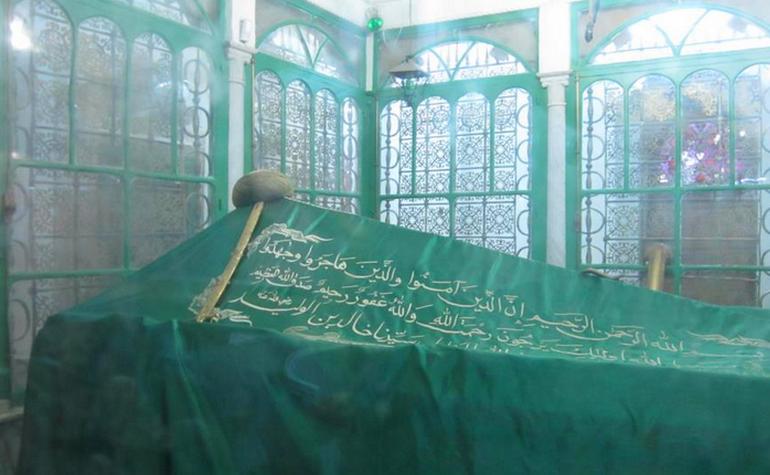Khalid-bin-Waleed (may Allah be pleased with him), the companion of Rasulullah (peace and blessings of Allah be on him) and the greatest Muslim general to have lived is buried along with his son in a corner of this mosque in Homs which has now been partially destroyed in the ongoing war in Syria. Khalid’s tombstone depicts a list of over 50 victorious battles that he commanded without defeat (not including small battles). A sword of his was also on display as well as a shield that was displayed outside.
Prior to him accepting Islam, Khalid fought on the side of the Quraysh in the Battle of Uhud and it was his military manoeuvres that led to the deaths of 70 Sahabah.
After embracing Islam, Khalid (may Allah be pleased with him) first took charge of a Muslim army at the Battle of Mu’ta after the three leaders appointed by the Prophet (peace and blessings of Allah be on him) had been martyred. He successfully commanded a protective withdrawal. Khalid (may Allah be pleased with him) broke 9 swords during combat in the battle and after the Battle of Mu’ta he was given the title Saifullah (Sword of Allah).
He was one of the most successful military commanders of all time. He is noted for his military prowess, commanding the forces of the Prophet (peace and blessings of Allah be on him) and those of his immediate successors of the Rashidun Caliphate; Abu Bakr and Umar ibn al-Khattab. He has the distinction of being undefeated in over a hundred battles, against the numerically superior forces of the Byzantine Roman Empire, the Sassanid Persian Empire, and their allies. His greatest strategic achievements were his swift conquest of the Persian Empire’s Iraq and conquest of Roman Syria within three years from 633 to 636 CE, while his greatest tactical achievements were his successful double envelopment maneuver at Walaja and his decisive victories at Yamamah, Ullais and Yarmouk.
In 631 CE he participated in the farewell Hajj of the Prophet (peace and blessings of Allah be on him). According to a narration, when the Prophet (peace and blessings of Allah be on him) shaved his head, Khalid (may Allah be pleased with him) took some of his hairs. When asked by the Prophet (peace and blessings of Allah be on him) the reason for this, he replied, “I will keep these hairs with me forever as a relic so that they will help me be victorious in battles.“ Later he sewed those hairs in his cap, which he always wore under his turban.
The tragedy of this great Sahabi was to die on his bed. He himself narrates, “ I attended such-and-such a battle, and such-and-such a battle, proceeding (towards the enemies); and there is no spot of my body but that it has either a sword’s strike, a spear’s pierce or an arrow’s throw. And now I’m dying on my bed, in the same way as the camel dies. May the eyes of the cowards never sleep.”
Scholars have commented that the reason he died a natural death was that he was ‘The Sword of Allah’ and thus it was not possible for him to be killed by another man.
References: Men around the Messenger – Khalid Mohammed Khalid, Wikipedia.
Note that this entry has been shown for information purposes only. On no account should anybody pray towards a grave or seek supplication through them as this is tantamount to committing shirk, associating partners with Allah (Glorified and Exalted is He)


No comments:
Post a Comment